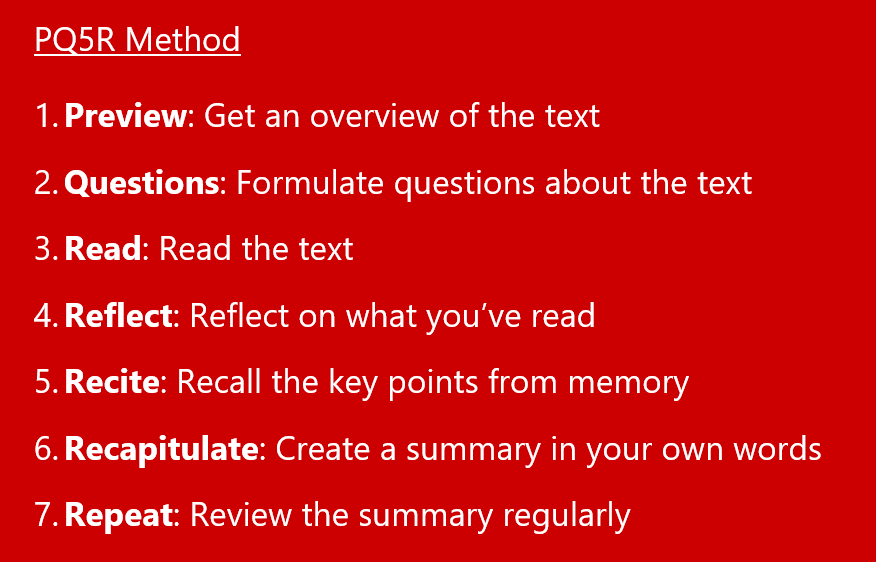PQ5R Method: Increase Your Text Comprehension In 7 Steps
The PQ5R method is a technique to enhance text comprehension and retain more of what you’ve read. This method involves processing the text in the following seven steps:

1. Preview: Get an Overview of the Text
The first step in the PQ5R method is to skim through the reading material to get an overview. The approach varies depending on whether you’re skimming a book or a regular text.
Text: Briefly skim the text to identify the topic and structure, paying attention to the title, subtitle, and emphasized sections, such as bolded or underlined keywords and phrases. It may also be helpful to read the first and last paragraphs, as the first typically contains information about the topic, author, purpose, and intent, while the last often provides a conclusion or summary. Look at paragraph lengths, images, graphics, and the general content of each section to understand the text’s structure.
Book: Review the cover, title, and back of the book to identify the theme and goals. Flip through the book to recognize the layout and use of images or graphics, then examine the table of contents and index if available. Lastly, read the beginning of the introduction and check out the chapter structures.
2. Questions: Formulate Questions about the Text
After skimming, formulate questions that you hope to answer while reading. This fosters curiosity and encourages you to look for specific passages that answer your questions. Be sure to write down both the questions and answers.
3. Read: Read the Text
Use your questions as a guide while reading, aiming to answer them. Additionally, ask yourself:
- What is the overall subject of the text or book?
- What details are provided, and how are they presented?
- Which parts are true or false?
- Which passages are important?
To help answer these, make highlights and notes in the margins or on a separate sheet. Underline or mark key sections, highlight important passages with a vertical line in the margin, and cross out irrelevant sections. This aids comprehension, as you naturally evaluate each passage’s importance, and it helps you quickly locate critical sections for review or summarization.
You can also mark the margin with stars for significant passages or chapters, circle key words, or add symbols for different types of information, such as a question mark for unclear points, “Ex.” for examples, “Def.” for definitions, or a hand symbol for practical applications.
After reading, go over the text again, reading your notes and highlights aloud to reinforce memory.
4. Reflect: Reflect on What You’ve Read
During and after reading, pause periodically to reflect on the material. Try to follow the flow of arguments and ask yourself if the content is entirely or partially true. Consider the author’s intent, which often helps clarify their arguments and objectives. The author’s main questions or problems are frequently presented at the beginning of the text or in the preface.
Think of additional examples, analogies, and your own experiences that relate to the text. In practical texts, think about ways to apply what you’ve learned.
5. Recite: Recall the Key Points from Memory
Put the text aside and try to recall as many main points as possible. Check what you’ve forgotten and, if necessary, repeat the process.
6. Recapitulate: Create a Summary in Your Own Words
Summarize the content in your own words and put your summary in writing. Ideally, illustrate your summary with a mind map or diagram.
7. Repeat: Review the Summary Regularly
The final step of the PQ5R method is to retain the information long-term through regular review. As in Step 5, try to recall as much as you can from memory, then check what you’ve forgotten.
Repeat this process at regular intervals to transfer the information to long-term memory through spaced repetition. It’s helpful to file your summary in your knowledge base for easy reference and repeated review.



